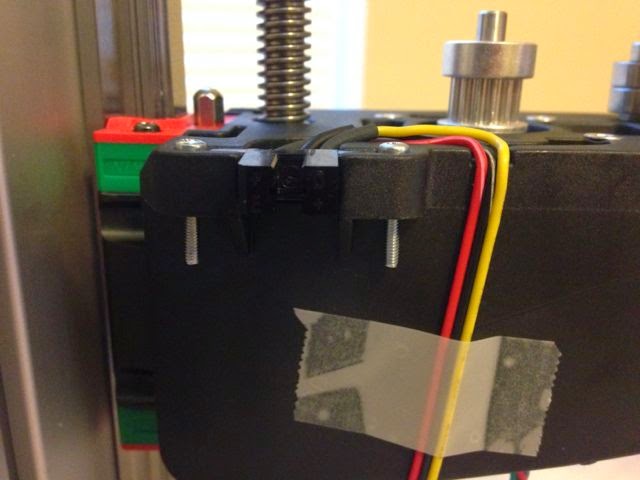- Remember the knob for the display? In my last post I said it looked like I needed to clear out some support material. Well, it looks like I was just supposed to shove it on. When I cleared out all the support material, there was no way to fasten the knob on. No big deal, though. I can just print a new one when I get the printer working.
- I was able to get the X, Y, and Z axes moving just fine under manual electric control. The Z axis was a bit squeaky at first, but I used some teflon lubricant and now the noise is gone.
- In the first (manual, non-electric) leveling step, it's kind of hard to visually estimate the distance between the hot end tip and the build plate. Then when I got to the fine adjustment stage I had difficulty getting the two hot ends exactly level.
- The final step before doing the first test print was to heat up the hot ends and extrude some filament under manual control. The instructions talk about adjusting the tensioning bolt to get it tight, but not too tight. Too tight can cause a clogged extruder. I fiddled with this for a while, but couldn't get the extruder wheel to grab the filament.
At this point I was thinking that between the difficulty leveling the hot ends vs. each other and the difficulty getting the filament to grab, I should take a second look at the extruder assembly. When putting it together, we had trouble with a couple of vertical bolts that didn't seem to be grabbing with the nuts inside the assembly. So I removed the outer fan and took a look. Sure enough, one of the nuts had grabbed, but the other had just been pushed aside in its slot.
As a reminder, this is how those nuts were inserted into the assembly...
Here's what it looks like from the side, with the nuts flat. They are supposed to be pinched enough in their slots so that they won't turn, and you can thread the bolt through to firmly fasten the extruder assembly onto the X-axis shuttle.
Here's what I found when I looked at that from the bottom. The one on the right threaded just fine, but the one on the left wouldn't. I sent a copy of this photo to the manufacturer, and they agreed that the plastic part on the left was defective. The cutout for the nut should be a symmetric half-circle. Probably the missing material there was why the nut wouldn't stay in place. They are sending me a replacement part, but it hasn't arrived yet. I did get one other suggestion from the discussion boards; use a thick nut instead of a thin one. I was able to find thick M4 nuts at Home Depot without any difficulty, and will substitute them when the new part comes.
Last night I also was able to resolve the extrusion issue. I just had to tighten the tension bolt a little more than I had initially been comfortable with.
When the replacement part comes, I should be able to get the two hot ends level and be good to go for the test print. Just a little longer!









































